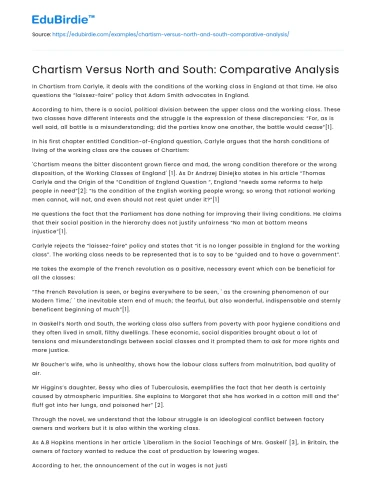In Chartism from Carlyle, it deals with the conditions of the working class in England at that time. He also questions the “laissez-faire” policy that Adam Smith advocates in England.
According to him, there is a social, political division between the upper class and the working class. These two classes have different interests and the struggle is the expression of these discrepancies: “For, as is well said, all battle is a misunderstanding; did the parties know one another, the battle would cease”[1].
Save your time!
We can take care of your essay
- Proper editing and formatting
- Free revision, title page, and bibliography
- Flexible prices and money-back guarantee
In his first chapter entitled Condition-of-England question, Carlyle argues that the harsh conditions of living of the working class are the causes of Chartism:
'Chartism means the bitter discontent grown fierce and mad, the wrong condition therefore or the wrong disposition, of the Working Classes of England' [1]. As Dr Andrzej Diniejko states in his article “Thomas Carlyle and the Origin of the “Condition of England Question “, England “needs some reforms to help people in need”[2]: “Is the condition of the English working people wrong; so wrong that rational working men cannot, will not, and even should not rest quiet under it?”[1]
He questions the fact that the Parliament has done nothing for improving their living conditions. He claims that their social position in the hierarchy does not justify unfairness “No man at bottom means injustice”[1].
Carlyle rejects the “laissez-faire” policy and states that “it is no longer possible in England for the working class”. The working class needs to be represented that is to say to be “guided and to have a government”.
He takes the example of the French revolution as a positive, necessary event which can be beneficial for all the classes:
“The French Revolution is seen, or begins everywhere to be seen, ' as the crowning phenomenon of our Modern Time;' ' the inevitable stern end of much; the fearful, but also wonderful, indispensable and sternly beneficent beginning of much”[1].
In Gaskell’s North and South, the working class also suffers from poverty with poor hygiene conditions and they often lived in small, filthy dwellings. These economic, social disparities brought about a lot of tensions and misunderstandings between social classes and it prompted them to ask for more rights and more justice.
Mr Boucher’s wife, who is unhealthy, shows how the labour class suffers from malnutrition, bad quality of air.
Mr Higgins’s daughter, Bessy who dies of Tuberculosis, exemplifies the fact that her death is certainly caused by atmospheric impurities. She explains to Margaret that she has worked in a cotton mill and the” fluff got into her lungs, and poisoned her” [2].
Through the novel, we understand that the labour struggle is an ideological conflict between factory owners and workers but it is also within the working class.
As A.B Hopkins mentions in her article 'Liberalism in the Social Teachings of Mrs. Gaskell' [3], in Britain, the owners of factory wanted to reduce the cost of production by lowering wages.
According to her, the announcement of the cut in wages is not justified and perceived by workers as totally unfair. She also analyses that Nicolas Higgins ignores that they would face harsh competition with American products if they got into the market when he says:
Why, yo' see, there's five or six masters who have set themselves again' paying the wages they've been paying two years past, and flourishing upon, and getting richer upon. And now they come to us and say we're to take less. And we won't. We'll just clem them to death first; and see who'll work for 'em then. They'll have killed the goose that laid the golden eggs, I reckon [4].
To conclude, both texts deal with the social, and economic conditions that suffered the working class at that time.
- Carlyle, T. Chartism, second edition, (London: James Fraser, Regent Street 1840). (pp.2, 3, 7, 43).
- Gaskell, E. North and South, Oxford University Press, Inc, 1973 (pp.102).
- Hopkins, Annette Brown. 'Liberalism in the Social Teachings of Mrs. Gaskell', Social Service Review, 5, 1, 1931, pp. 57-73.
- Gaskell, Elizabeth. North and South, Penguin Classics, 2012 (pp.161).






 Stuck on your essay?
Stuck on your essay?

